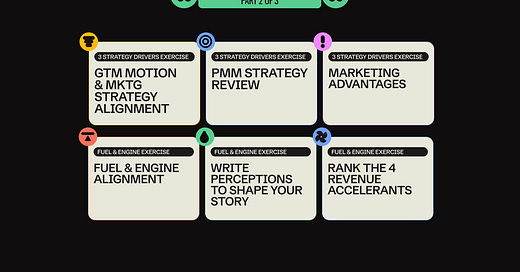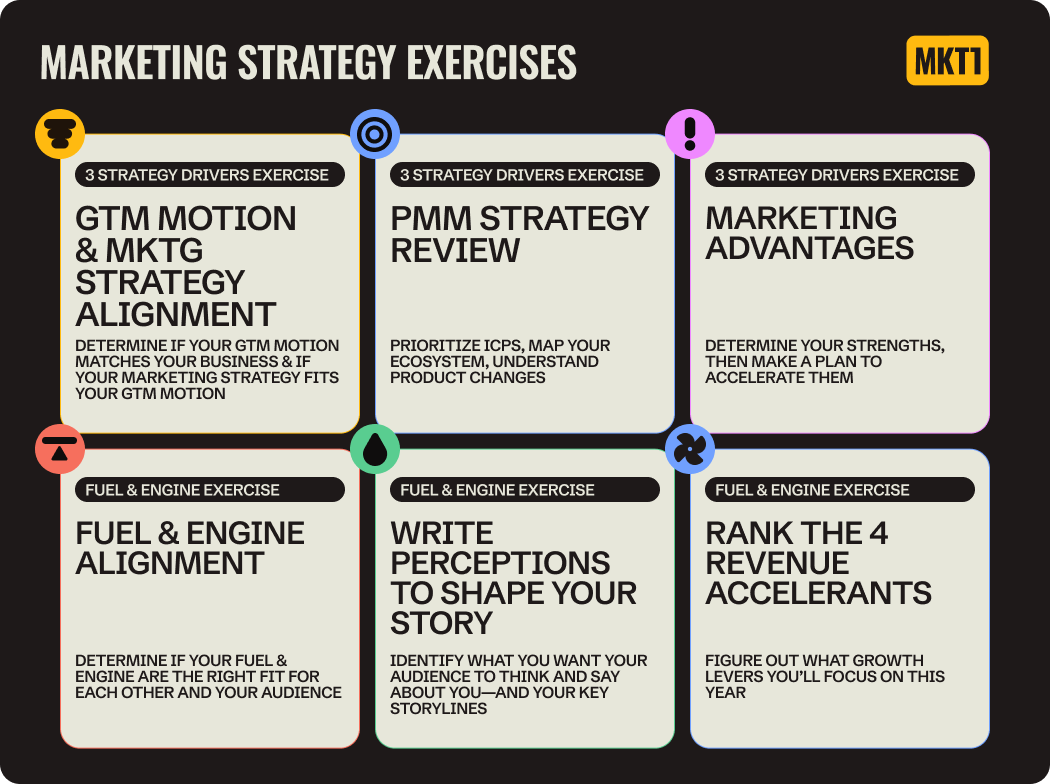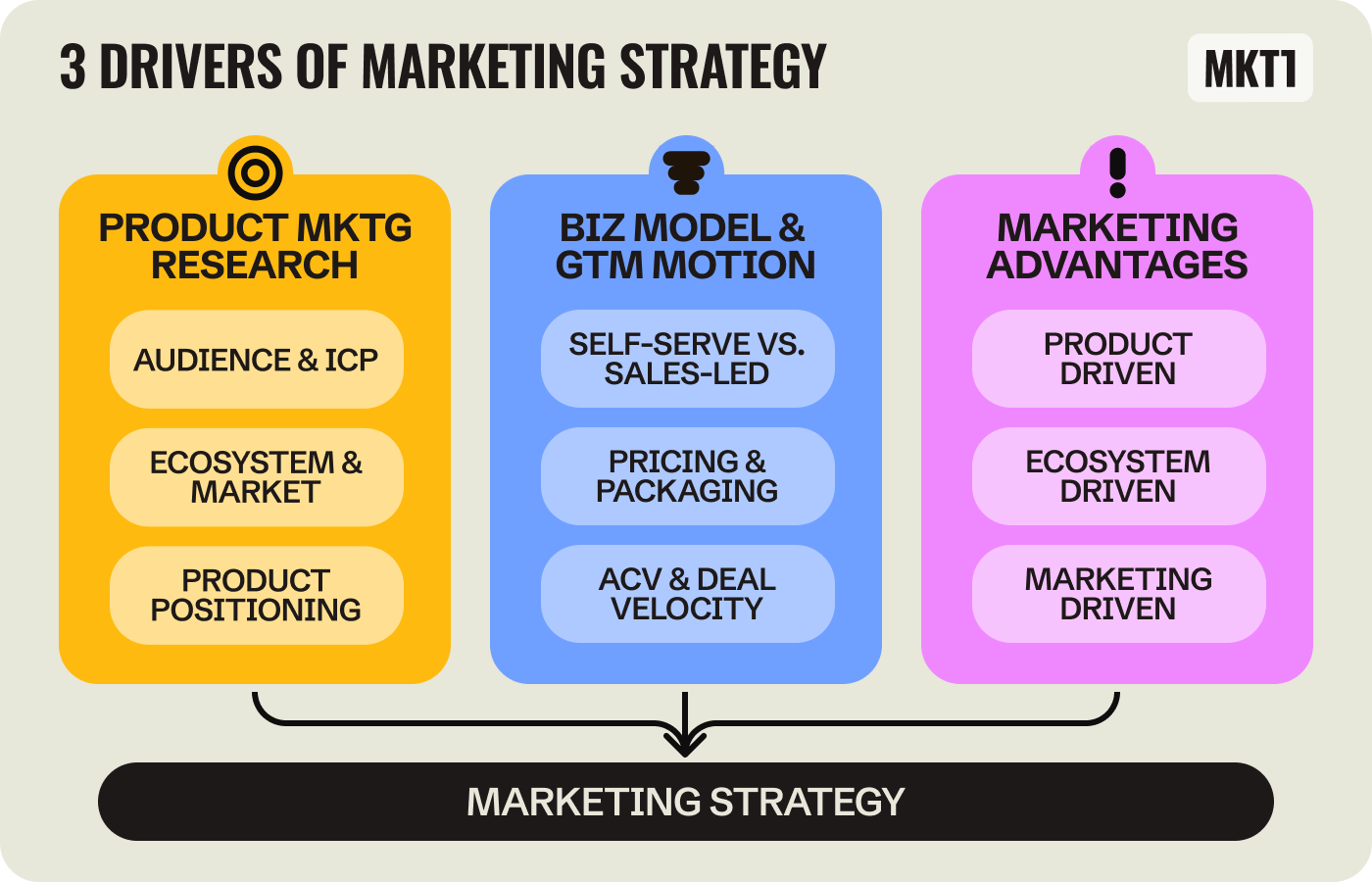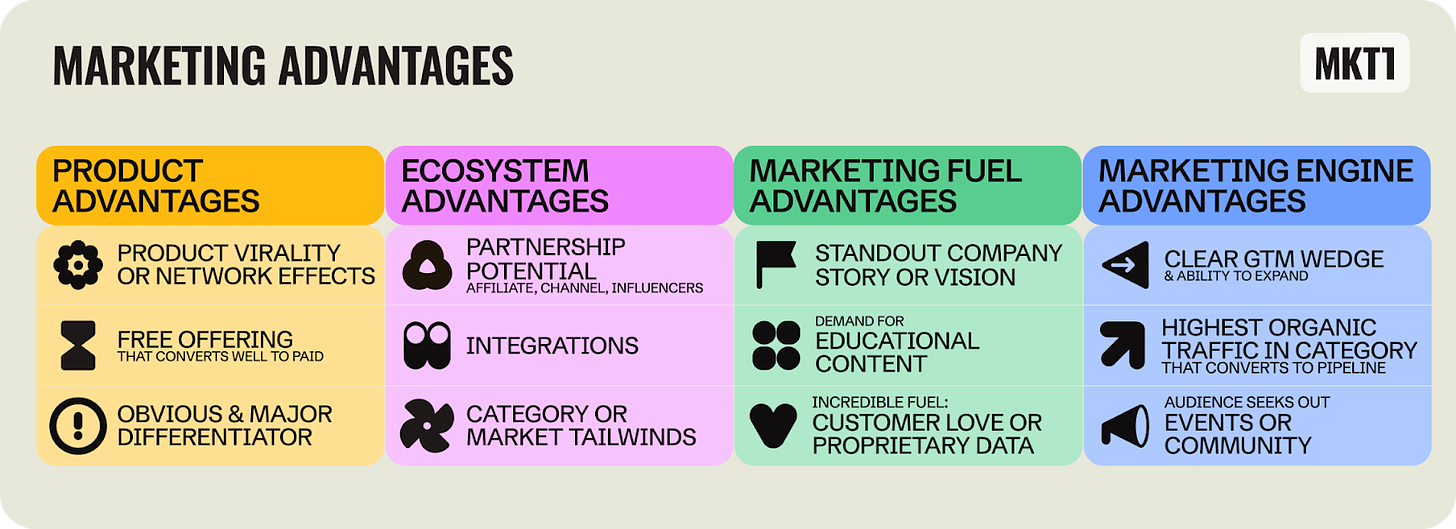Marketing strategy exercises to kick off your annual planning process
Annual Marketing Planning Series - Newsletter 2. Includes detailed instructions for running 6+ cross-functional marketing strategy exercises.
👋 This is a bonus, second monthly free edition of MKT1 Newsletter—part of a series of 3 newsletters on Planning. Become a paid subscriber to receive all newsletters, access our archives, post to our job board, use our template library, and attend monthly office hours with Kramer.
The point of planning for the quarter or year isn’t to pick a random MQL number, get budget approval, and call it a day. When done right, the planning process is just as important, if not more, than the end result.
As I said in last week’s newsletter: "The primary purpose of marketing planning is to determine how to drive revenue growth today, how to set the company up for long-term growth, and how to do this efficiently–and to get everyone in the company on board with the plan."
I’ll add one more thing to this statement: The secret to marketing planning is figuring out how your startup’s marketing is differentiated. Maybe you already know how your product is differentiated, but your marketing strategy must be differentiated too. You can’t just copy another company’s playbook or do exactly what you did last year.
To figure this out, you need to zoom back out to your marketing strategy. You need to do the work to discover your secret sauce, your marketing strengths, and the big things that will drive audience engagement and revenue at this moment in time. Yes this takes time strategizing, researching, brainstorming, and collaborating cross-functionally, but your resulting marketing plan will be much more effective if you take time for strategy exercises to kick off your planning process.
This newsletter is part 2 of a 3 part series on marketing planning:
I share the strategy exercises I use to evaluate marketing strategy before diving deeper into annual planning:
Exercises to identify and update the 3 strategy drivers: Includes product marketing exercises, GTM motion evaluation, and identifying marketing advantages.
Exercises to define your “fuel” and “engine” strategies for the year: Includes identifying your storylines, ranking revenue “accelerants”, and checking for fuel and engine alignment.
Other newsletters in this series on planning:
Planning Part 1: Anatomy of a marketing plan
Planning Part 2: This newsletter!
Planning Part 3: Prioritization of marketing ideas
Bonus Part 4: Setting a marketing budget & tracking efficiency metrics
Extras for paid subscribers:
Templates to run all of the exercises in this newsletter
Recommended products and agencies
Naro is the solution for marketers who get endless requests for sales enablement content. During calls, Naro suggests relevant content to sales teams. It then uses AI to analyze those calls and emails to highlight gaps in your content library–so marketers can focus on making what’s really needed.
Offer: Reach out to Naro and mention MKT1 to get your first 2 months free.
____
Flow Agency works with B2B SaaS companies to generate inbound opportunities from paid & organic search—and prepare you for the new world of AI-powered search and LLMs. You’ll work directly with a senior consultant, who can help you grow your search efforts next year and beyond.
Offer: Reach out to Flow and mention MKT1 to get 15% off your first 3 months.
____
Caspian Studios produces podcasts for B2B companies–and will be producing my upcoming podcast too! Whether you want an interview-style podcast or a fiction series with real actors, they’ve done it before with companies like Qualified, Snowflake, Gympass, Workato and Brex.
Offer: Reach out to Caspian and mention MKT1 to get $1,000 off your podcast.
How these strategy exercises fit into the annual marketing planning process:
Before you start prioritizing work and setting goals, you should revisit your marketing strategy.
Dedicate time over a couple of weeks for strategy sessions with marketing and cross-functional teams.
You don’t need to run all of the exercises I mention here during annual planning (that would be a lot), pick the ones that you think need the most attention and/or will have the most impact on your strategy this year.
In the future, I recommend you find time for some of these exercises throughout the year, so it all doesn’t hit during an annual or quarterly planning cycle.
As you go through these exercises, I recommend keeping a running list of ideas, work, and projects you might do. I’ll be writing more about how to prioritize this list in my next newsletter!
And as you finish an exercise, create a summary of the takeaways, this will ultimately go into the planning doc you share cross-functionally, along with a link to the exercise doc with all the details. Paid subscribers can access this planning doc template here.
Note: These frameworks and exercises are all made by MKT1. They aren’t universally used, so saying, “Hey team, let’s look at those 3 marketing strategy drivers and then run through marketing advantages like we practiced in b-school” is going to get you confused looks. Unless of course your whole team reads the MKT1 Newsletter, which I hope they do. 😊
Exercises to evaluate your 3 strategy drivers
In these exercises, you’ll revisit your high-level marketing strategy. To clarify what’s involved in a marketing strategy, I’ve organized the key inputs into what I call the “3 strategy drivers”.
By using these 3 drivers as inputs, you’ll be sure your marketing strategy aligns with your audience, your GTM motion and business model, and your unique strengths as a company–instead of running a marketing playbook fit for another business.
Exercise: Product marketing strategy review
🔑 Purpose of exercise: Determine if their are any major learnings or planned changes to your target audiences/ICPs, any major happenings in your ecosystem or market (whether a competitor, complement, or trend), any major product updates, and whether these changes demand a positioning update—either overall or for one ICP.
🖼️ Framework overview:
Product marketing is the foundation for almost everything you do in marketing—and it doesn’t just include understanding your product. It means deeply understanding your audience, market & ecosystem, and product.
🙋 Typical Stakeholders:
DRI (directly responsible individual): Head of Product Marketing
Key marketing stakeholders: Product Marketing team, Head of Marketing
Key cross-functional stakeholders: Product, Partnerships, Sales
🏃 How to run:
These 3 exercises can be done together or separately. If you have a strong foundation already, these can even potentially be done asynchronously and shared for feedback.
Part 1: Prioritize ICPs using a tier system
Rather than going after all audiences with the same intensity and set of activities, use tiers to indicate current maturity of each ICP, I typically use these buckets: proven, scaling, testing, and not (currently) a priority.
Then rank or indicate percentages of effort you want to give to each tier for the next year or quarter.
Get buy in on this prioritization from other GTM teams, if not the entire company.
Part 2: Map your ecosystem
Startups tend to over-focus on competitors and not spend enough time thinking about complements. By complements, I mean third-parties/potential partners that can help them drive growth.
To make sure you’ve thought this through, it can be helpful to map all the players in your ecosystem-especially potential partners who could help you grow this year or in the future..
You can categorize these potential partners in the following buckets: Affiliates & referrers, channel partners, integration Partners, and marketing partners,
I’ll be writing all about ecosystem marketing in November, and there’s a short template for this for paid subscribers.
Part 3: Align with product strategy
Meet with the product team to understand any updates to the product strategy and talk through the product roadmap
Start to talk about the ICP, funnel stage, and potential impact of each launch
Add launches and product changes to your list of projects for next year.
⛳ Common pitfalls:
Sticking with one ICP for too long or the flip side, switching between ICPs without doing enough work to test the viability.
Underestimating the power of complementary products and services and their ability to help you grow.
Not understanding the product direction before you make your marketing strategy and plans for the year.
📚 Additional reading & templates:
Newsletter: Positioning Guide
Newsletter: What is Product Marketing?
Exercises or audience tiering, ecosystem mapping, and positioning for paid subscribers
Exercise: GTM motion <> Marketing strategy alignment
🔑 Purpose of exercise: Evaluate if your GTM motion is helping you grow revenue effectively. Then, assess if your marketing strategy is right for your business model and go-to-market motion (self-serve vs. sales-led vs. hybrid). These are the potential outcomes from this exercise:
1. You realize you need to revisit your GTM motion, sales process, pricing and packaging as they don’t align with what’s best for your audience.
2. You realize you need to revisit your marketing strategy, tactics, and/or channels to better align with your GTM motion, sales process, pricing and packaging, average contact value etc.
🖼️ Framework overview:
GTM motions for B2B SaaS businesses typically include: Self-serve, sales-led, or hybrid (a combo of the 2).
Quick note: I define self-serve as being able to sign up and use the product without talking to sales; I define sales-led as needing to interact with a human on the sales team to purchase. Product-led growth is a broader overall strategy, which can include self-serve sign up, but they aren’t exactly the same thing. More on my definitions here.
🙋 Typical Stakeholders:
DRI (directly responsible individual): Head of Growth Marketing or Head of Marketing
Key marketing stakeholders: Head of Product Marketing, Head of Marketing, Marketing Ops
Key cross-functional stakeholders: Sales, Finance, Product
🏃 How to run:
Part 1: To determine if you have the right GTM motion, assess the following:
Product adoption: Is it possible for users to sign up and onboard on their own today? How much lift would be necessary to get there? Does your product make sense to be brought in to an organization bottom-up (by end users) or top-down (by decision makers).
Product-led growth potential and virality: Will users directly or indirectly share your product with people inside their company or outside? Is there network effect potential? If so, self-serve can help accelerate growth.
Audience preferences: Look at competitive and complementary products for your same audience, are they self-serve or sales-led? Talk to potential customers, ask how they prefer to buy.
Average contract value and range of deal sizes: If your average contract value is under ~$10K, self-serve likely makes sense. If you have a range of deal sizes, a hybrid model might make sense, where you offer self-serve for smaller deal sizes and sales-led for higher.
Time to close: If you have self-serve motion today, how quickly do they upgrade? If sales-led, how long is the sales-cycle? With really short sales-cycles, it might mean people are ready to buy and sales is slowing down the process. If it takes a long time for users to upgrade in the product, more product growth tests and/or adding in a sales-assist for high value users may help.
Part 2: To determine if your marketing strategy aligns with your GTM motion:
Review this diagram and identify any areas of misalignment
e.g. If you have a sales-led motion, but are only using inbound channels, it may make sense to layer in outbound to accounts sales would like to focus on.
e.g. If you are gating content, but have a self-serve motion and an easy product to adopt, it likely makes more sense to ungate the content and drive users right into your product.
Part 3: Assess impact of any needed changes:
If you need to add an additional GTM motion into the mix, this needs to be a company-wide effort and commitment. It will impact RevOps, billing, sales process, product onboarding needs, etc. Make sure this is on everyone’s radar for the quarter or year.
If you realize you should be experimenting with different marketing strategies and tactics to better suit your GTM motion or business attributes, add this to your list of potential projects for the year.
⛳ Common pitfalls:
Getting pushback from sales when suggesting adding a self-serve model. Modeling the impact on revenue due to higher conversion rates and a shorter funnel with finance can help here. Garnering the support of the product team first can also help.
Marketers who have only worked at companies with one GTM motion, may struggle to figure out the tactics that work best for their current startups GTM motion. e.g. It’s hard to adapt to a self-serve model and the channels you’ll use if you only have experience at a sales-led company.
📚 Additional reading
Newsletter: How your GTM motion impacts your marketing strategy and org chart
Exercise: Identify your marketing advantages—and plan how you’ll leverage them
Note for regular MKT1 readers: Since we wrote our original newsletter on marketing advantages, I’ve identified some new advantages based on working with more companies. So while that original post is a great reference, the above diagram an updated version of the framework with re-categorized with 2 new advantages.
🔑 Purpose: Startups need to play to their strengths—and not try to copy what’s worked elsewhere. In this exercise, you’ll identify (or review, if you’ve done this work before) your marketing advantages. Then you’ll prioritize your advantages and make a plan for how you can accelerate each through marketing work.
🖼️ Framework overview:
The key to creating a high-impact marketing plan = identifying the big bet projects that have the potential to change your startup’s growth trajectory.
The key to figuring out your big bet projects = understanding your marketing advantages.
Marketing advantages are dynamics in a company’s business, product, or market; when leveraged they can help you grow much faster. In other words, they are catalysts for growth.
Most successful late-stage companies leveraged 2+ marketing advantages to get where they are today.
Startups should recognize, prioritize, and accelerate these advantages to win. Tailor your marketing strategy, content, and channels based on your specific advantages.
🙋 Typical Stakeholders:
DRI: Head of Marketing
Key marketing stakeholders: Marketing team leaders: Head of Product Marketing, Head of Growth Marketing, Head of Content & Brand
Key cross-functional stakeholders: Founders
🏃 How to run:
Identify which marketing advantages you have and indicate the potential strength of that advantage (if fully leveraged) for your company.
E.g. Ecosystem Advantages: High - Channel partnerships could be a very strong advantage for us through partnering with service providers.
E.g. Marketing Engine Advantages: High - We have a 10% conversion from new web visitors to sign up, and 10% conversion from free to paid.
Then, determine the current strength of the advantage. Are you leveraging this to it’s fullest extent?
E.g. “Medium - We haven’t done enough to turn service providers into channel partnership beyond 2-3 providers to date”
E.g. “High - our free plan is core to how we drive growth, and we’ve optimized conversion rates throughout the funnel”
Identify if competitors have the same advantage(s)–is it just as strong for them? How are they leveraging it?
E.g. CoyoteCo could also use channel partners to grow, but we don’t believe they are pursuing this strategy and their founding team doesn’t have the industry relationships we have.
E.g. No competitors have a free plan yet, we’ve successfully been using this advantage to land grab.
Prioritize building a marketing strategy for this advantage this quarter or year–do you need to start focusing here or double down on what you’re already doing?
E.g. We need to put effort into channel partners asap, p1
E.g. We need to stay the course with focusing our self-serve motion, free-plan, and conversion, p2
Determine what projects will help you accelerate the advantages you’ve indicated as a priority.
E.g. Hire a partner marketer to focus on channel partnerships program
E.g. Product to build dashboard and product experience for channel partners
Summarize the advantages you have, which ones you are focused on, and add any projects to your running list of potential initiatives.
e.g. We have both a partnerships advantage through service providers and a product advantage in that we have free plan that converts. We will win by growing our channel partners, driving inbound and referral traffic to our free plan, and using lifecycle marketing to drive conversion to the paid product.
⛳ Common pitfalls:
Recognizing you have an advantage, but thinking it will just naturally catalyze growth. This is true to a point, but if you throw fuel on these marketing advantage fires, you’ll grow even faster!
For certain advantages, the entire company needs to be on board to accelerate it–make sure to get buy in. E.g. Discuss network effects with product; ecosystem advantages with other GTM teams, etc.
In some cases, you may not have the advantage yet, but you can create these advantages, and the benefit of having one of these advantages is worth the investment to get there (think launching a free plan, or narrowing your focus to a wedge-in strategy). Other advantages are hard to force—like your company story or a demand for educational content.
📚 Additional reading & exercise:
Newsletter: Find & accelerate your marketing advantages to grow much faster
Exercise: List of advantages with explanations and suggested tactics, plus checklist & exercise
Fuel & engine strategy exercises
Perhaps my most popular framework is Fuel & Engine. To build a high-impact marketing machine, you must combine fuel & engine.
Fuel is the content and creative you distribute through your engine. Your engine are the channels and targeting you use to distribute fuel to your audience. Your fuel and engine need to be aligned with each other.
After you’ve mapped your 3 strategy drivers, make sure your fuel & engine strategy align with those high-level inputs. This diagram is an overview of what I include in “fuel strategy” and “engine strategy”:
These exercises help you determine how you will make content and creative that your target audience will engage with and how you’ll distribute said fuel for each of your target audiences.
Fuel Strategy Exercise: Perceptions
🔑 Purpose: Establishing perceptions helps your startup keep its content focused on major themes—so your story actually resonates and sticks with your audience.
🖼️ Framework overview: Perceptions are the statements you want your audience to think or say about you. You can also think about them as your key storylines for the year.
🙋 Typical Stakeholders:
DRI: Brand &/or Content Leader
Key marketing stakeholders: Product marketing, Head of Marketing
Key cross-functional stakeholders: Founders, Product Design Leader, Customer Success
🏃 How to run:
Make sure you have a deep understanding of your audience, historical content performance, and an understanding of trends in your space.
Run an exercise where stakeholders answer key questions about your story. These questions can include:
How will your audience’s work lives change if your company is wildly successful? What are the unique points of view that shape your product or company strategy? What do customers already say about you? Are you part of a change or trend in your market—what are the headwinds or tailwinds you’re facing as a business? What's unique about your customers and people who choose to use your product? More questions available in our template for paid subscribers.
Refine these answers into 3-4 rough themes as a group.
Then, reword them in the voice of a customer. This can be done async by the DRI. If helpful, you can map your themes to each of these: customer/community commonalities, highest-level product story, company story or insight, and market/ecosystem trends or changes.
Validate that these are the right perceptions: Are your perceptions broad enough that 90% of your (non-seo-focused) content for the next year can ladder up to a perception?
Example output for some fictional animal-themed companies:
Product-related: If I (a person in YetiCo’s target audience) am considering Snowflake, I should also consider YetiCo.
Trend-related: With the fed lowering interest rates, CoyoteCo’s product is more critical than ever.
Community/content related: If I’m trying to architect my martech stack, MarmotCo has the best content to learn.
Company story-related: MonkeyCos founder first built this tool internally at Amazon, so I know it can work at scale.
⛳ Common pitfalls:
The combination of your perceptions should not be “claimable” by any other startup. An individual perception might be duplicative with another company story, but when in combination they should be highly differentiated. This ensures your content/fuel strategy feels unique.
Following the theme buckets I list above to a tee is a mistake. This is your story. Determine the best format and way to structure your high-level storylines—you need them to have an effective and focused fuel strategy!
📚⠀Additional reading & template
Newsletter: Perceptions (an old one that still holds up, I think)
Exercise: Cross-functional perceptions exercise
More from MKT1
🙏 Thanks again to our sponsors: Naro, the solution for marketers who get endless requests for sales enablement content; Flow Agency, who works with B2B SaaS companies on paid & organic search; and Caspian Studios who produces podcasts for brands, including my podcast.
✂️ Templates for paid subscribers: Paid subscribers can find planning and strategy templates here and at the very bottom of this newsletter.
👁️ Related newsletters: Anatomy of a marketing plan, How to prioritize marketing activities, and Setting a marketing budget & tracking efficiency metrics
🧑🚀 Job board: Jobs from the MKT1 community. Paid subscribers can add jobs to our job board for free.
📖 Keep reading: Paid subscribers get access to the rest of this newsletter which includes engine strategy exercises (ranking the 4 revenue accelerants) & fuel and engine alignment exercises.









